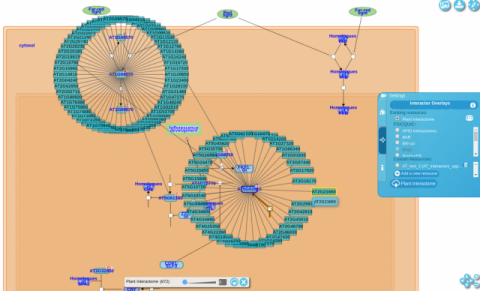Gramene release # 56b: updates to Plant Reactome
In Gramene release 56b, we present recent updates of Plant Reactome, the pathway portal of Gramene. We have added 22 newly curated pathways, 3 updated pathways, 8 newly projected species, and gene interaction data to Plant Reactome. The Plant Reactome database was built in collaboration with the Reactome project.
Pathway Curation
This release contains 22 newly curated and 3 revised pathways from reference species rice (O. sativa). The hierarchical list of pathways has been updated accordingly.
Newly curated pathways:
- Reproductive structure development
- Anther and pollen Development
- Vegetative structure development
- Primary root development
- Response to submergence
- Underwater shoot and internode elongation
- Response to phosphate deficiency
- Photorespiration
- Ureide biosynthesis
- Beta-alanine betaine biosynthesis
- Proline biosynthesis V from arginine
- Phospholipid biosynthesis I
- Sphingolipid metabolism
- Response to iron deficiency
- Mugineic acid biosynthesis
- Iron uptake and transport in root vascular system
- Proline degradation
- Glutamate degradation
- Phenylalanine degradation III
- Lysine degradation II
- Threonine degradation
Revised pathways:
- Cardiolipin biosynthesis
- Ent-kaurene biosynthesis
- Responses to stimuli
Pathway Projections (8 new species included)
The Plant Reactome has expanded gene homology-based pathway projections to 74 plant species. Newly projected species include garden cucumber (Cucumis sativus), white yam (Dioscorea rotundata), sunflower (Helianthus annuus), white jute (Corchorus capsularis), blue lupin (Lupinus angustifolius), coyote tobacco (Nicotiana attenuata), Irish moss (Chondrus crispus), and an extremophilic unicellular species of red algae Galdieria sulphuraria (capable of photosynthesis as well as heterotrophic growth by utilizing ~50 different extracellular carbon sources).
In addition, we have revised pathway projections (converted from Inparanoid to Compara orthology) for three species: a wild South American cotton (Gossypium raimondii), cassava (Manihot esculenta), and common bean (Phaseolus vulgaris). Notable updated Compara orthology data has been kindly provided by Ensembl for updated species.
Pathway Projection Statistics and Status (update/new)
- *data from sequenced transcriptomes
- ^ projections currently exclude cell-cycle pathways and annotations
- Planteome Inparanoid data was kindly provided by the Planteome project
- When available the outgoing links from gene product IDs mapped to reactions are always hyperlinked to respective entries in collaborator databases/online resources
| Species | Pathways | Reactions | Gene Products | Sequence source | Homology method |
| Oryza sativa japonica | 264^ | 1168 | 1384 | Ensembl Gramene | Curated Reference |
| Aegilops tauschii | 202 | 489 | 889 | Ensembl Gramene | Compara |
| Amborella trichopoda | 213 | 538 | 647 | Ensembl Gramene | Compara |
| Arabidopsis lyrata | 213 | 544 | 1040 | Ensembl Gramene | Compara |
| Arabidopsis thaliana | 214 | 551 | 1027 | Ensembl Gramene | Compara |
| Arachis duranensis | 218 | 529 | 825 | PeanutBase | Inparanoid |
| Arachis ipaensis | 216 | 535 | 847 | PeanutBase | Inparanoid |
| Beta vulgaris | 212 | 540 | 745 | Ensembl Gramene | Compara |
| Brachypodium distachyon | 208 | 561 | 926 | Ensembl Gramene | Compara |
| Brassica napus | 212 | 539 | 2953 | Ensembl Gramene | Compara |
| Brassica oleracea | 214 | 539 | 1531 | Ensembl Gramene | Compara |
| Brassica rapa | 211 | 543 | 1555 | Ensembl Gramene | Compara |
| Cajanus cajan | 218 | 547 | 1097 | LegumeInfo | Inparanoid |
| Capsicum annuum | 217 | 529 | 1047 | PMID: 24441736 | Inparanoid |
| Chlamydomonas reinhardtii | 161 | 317 | 264 | Ensembl Gramene | Compara |
| Chondrus crispus | 134 | 230 | 194 | Ensembl Gramene | Compara |
| Cicer arietinum | 219 | 544 | 1306 | NCBI | Inparanoid |
| Citrus sinensis | 218 | 541 | 2176 | Phytozome | Inparanoid |
| Coffea canephora | 218 | 542 | 949 | PMID:25190796 | Inparanoid |
| Corchorus capsularis | 210 | 526 | 756 | Ensembl Gramene | Compara |
| Cucumis sativus | 211 | 536 | 810 | Ensembl Gramene | Compara |
| Cyanidioschyzon merolae | 135 | 242 | 182 | Ensembl Gramene | Compara |
| Dioscorea rotundata | 203 | 451 | 563 | Ensembl Gramene | Compara |
| Erythranthe guttata | 204 | 492 | 659 | Phytozome | Inparanoid |
| Eucalyptus grandis | 206 | 491 | 690 | Phytozome | Inparanoid |
| Fragaria vesca | 218 | 522 | 905 | Phytozome | Inparanoid |
| Galdieria sulphuraria | 139 | 257 | 207 | Ensembl Gramene | Compara |
| Glycine max | 214 | 542 | 1911 | Ensembl Gramene | Compara |
| Gossypium raimondii | 213 | 551 | 1382 | Ensembl Gramene | Compara |
| Helianthus annuus | 212 | 533 | 1496 | Ensembl Gramene | Compara |
| Hordeum vulgare | 213 | 534 | 925 | Ensembl Gramene | Compara |
| Jatropha curcas | 204 | 483 | 526 | KDRI (Kazusa) | Inparanoid |
| Leersia perrieri | 216 | 554 | 917 | Ensembl Gramene | Compara |
| Lupinus angustifolius | 183 | 379 | 593 | Ensembl Gramene | Compara |
| Malus domestica | 216 | 526 | 1811 | PMID: 20802477 | Inparanoid |
| Manihot esculenta | 215 | 549 | 1207 | Ensembl Gramene | Compara |
| Medicago truncatula | 210 | 538 | 1183 | Ensembl Gramene | Compara |
| Musa acuminata | 207 | 506 | 1172 | Ensembl Gramene | Compara |
| Nicotiana attenuata | 205 | 461 | 684 | Ensembl Gramene | Compara |
| Oryza australiensis * | 213 | 502 | 1527 | OMAP/OGE | Inparanoid |
| Oryza barthii | 214 | 565 | 948 | Ensembl Gramene | Compara |
| Oryza brachyantha | 215 | 563 | 922 | Ensembl Gramene | Compara |
| Oryza glaberrima | 218 | 560 | 947 | Ensembl Gramene | Compara |
| Oryza glumaepatula | 218 | 571 | 962 | Ensembl Gramene | Compara |
| Oryza longistaminata * | 213 | 538 | 825 | Ensembl Gramene | Compara |
| Oryza meridionalis | 209 | 506 | 817 | Ensembl Gramene | Compara |
| Oryza meyeriana var. granulata | 217 | 523 | 3155 | OMAP/OGE | Inparanoid |
| Oryza minuta * | 218 | 532 | 1845 | OMAP/OGE | Inparanoid |
| Oryza nivara | 214 | 570 | 953 | Ensembl Gramene | Compara |
| Oryza officinalis * | 215 | 533 | 1686 | OMAP/OGE | Inparanoid |
| Oryza punctata | 213 | 566 | 968 | Ensembl Gramene | Compara |
| Oryza rufipogon | 216 | 573 | 968 | Ensembl Gramene | Compara |
| Oryza sativa aus subgroup | 169 | 255 | 320 | PMID: 24578372 | Inparanoid |
| Oryza sativa Indica Group | 220 | 586 | 1049 | Ensembl Gramene | Compara |
| Ostreococcus lucimarinus | 144 | 294 | 239 | Ensembl Gramene | Compara |
| Phaseolus vulgaris | 214 | 548 | 1052 | Ensembl Gramene | Compara |
| Phoenix dactylifera | 211 | 508 | 995 | PMID: 23917264 | Inparanoid |
| Physcomitrella patens | 199 | 471 | 928 | Ensembl Gramene | Compara |
| Picea abies | 213 | 491 | 1183 | Congenie | Inparanoid |
| Pinus taeda | 202 | 438 | 1140 | TreeBase | Inparanoid |
| Populus trichocarpa | 213 | 554 | 1305 | Ensembl Gramene | Compara |
| Prunus persica | 214 | 552 | 929 | Ensembl Gramene | Compara |
| Selaginella moellendorffii | 209 | 514 | 1170 | Ensembl Gramene | Compara |
| Setaria italica | 212 | 566 | 1017 | Ensembl Gramene | Compara |
| Solanum lycopersicum | 213 | 545 | 1012 | Ensembl Gramene | Compara |
| Solanum tuberosum | 207 | 527 | 964 | Ensembl Gramene | Compara |
| Sorghum bicolor | 214 | 572 | 1001 | Ensembl Gramene | Compara |
| Synechocystis pcc6803 | 147 | 299 | 217 | Jaiswal | Inparanoid |
| Theobroma cacao | 214 | 554 | 874 | Ensembl Gramene | Compara |
| Trifolium pratense | 214 | 538 | 964 | Ensembl Gramene | Compara |
| Triticum aestivum | 214 | 570 | 3189 | Ensembl Gramene | Compara |
| Triticum turgidum * | 216 | 545 | 2482 | PMID: 23800085 | Inparanoid |
| Triticum urartu | 203 | 497 | 811 | Ensembl Gramene | Compara |
| Vitis vinifera | 212 | 539 | 875 | Ensembl Gramene | Compara |
NOTE: The pathway counts for both reference and projected species include a few organizational “container” names, such as “Hormone biosyntheses” and “Metabolism”. Additionally, the bulk of the projected pathways occur in the areas of metabolic and regulatory function, whereas the rice reference data set has additional pathways related to cell cycle functions. We are not currently using these additional pathways as a source for orthology projection. Visit the Download page to access the updated data files associated with pathways, reactions, gene products, metabolites and external reference sources such as ChEBI, Ensembl, and UniProt.
New Functionalities:
Expanded Reference Species Gene Name listings
Additional and alternate O. sativa gene names are now visible under the Molecules tab when viewing rice pathways.
Interactor Overlays
Users can display gene-gene interaction data on Plant Reactome pathways either by choosing a publicly-available dataset under “Interactor Overlay”, or by uploading a dataset of their choice. This feature can aid researchers by extending the network of known complexes and pathways with candidate proteins. The Plant Reactome team has specifically provided locally-hosted interaction data for A. thaliana (courtesy of the Planteome project). This data can be viewed by selecting “Plant Interactome” on the Interactor Overlay panel and A. thaliana on the species selector.

- Sushma_Naithani's blog
- Log in to post comments
